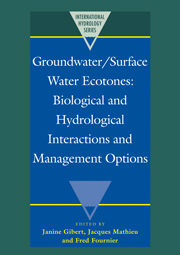Book contents
- Frontmatter
- Contents
- List of authors
- Preface
- I INTRODUCTION
- II FUNCTION OF GROUNDWATER / SURFACE WATER INTERFACES
- III MALFUNCTION OF GROUNDWATER / SURFACE WATER INTERFACES: CAUSES AND METHODS OF EVALUATION
- 19 Heterogeneity of groundwater-surface water ecotones
- 20 Failure of agricultural riparian buffers to protect surface waters from groundwater nitrate contamination
- 21 Stable nitrogen isotope tracing of trophic relations in food webs of river and hyporheic habitats
- 22 La zone hypodermique du sol écotone entre eaux météoriques et eaux souterraines dans l'infiltration des pesticides dissous
- 23 Soils of the north-eastern coast of the Caspian Sea as the zone of sea water/groundwater interaction
- IV MANAGEMENT AND RESTORATION OF GROUNDWATER / SURFACE WATER INTERFACES
- V CONCLUSION
- ANNEX
23 - Soils of the north-eastern coast of the Caspian Sea as the zone of sea water/groundwater interaction
Published online by Cambridge University Press: 07 September 2010
- Frontmatter
- Contents
- List of authors
- Preface
- I INTRODUCTION
- II FUNCTION OF GROUNDWATER / SURFACE WATER INTERFACES
- III MALFUNCTION OF GROUNDWATER / SURFACE WATER INTERFACES: CAUSES AND METHODS OF EVALUATION
- 19 Heterogeneity of groundwater-surface water ecotones
- 20 Failure of agricultural riparian buffers to protect surface waters from groundwater nitrate contamination
- 21 Stable nitrogen isotope tracing of trophic relations in food webs of river and hyporheic habitats
- 22 La zone hypodermique du sol écotone entre eaux météoriques et eaux souterraines dans l'infiltration des pesticides dissous
- 23 Soils of the north-eastern coast of the Caspian Sea as the zone of sea water/groundwater interaction
- IV MANAGEMENT AND RESTORATION OF GROUNDWATER / SURFACE WATER INTERFACES
- V CONCLUSION
- ANNEX
Summary
ABSTRACT The north-eastern coast of the Caspian Sea is a flat plain formed after the sea level drop in 1930–1977. For this shallow part of the Caspian Sea wind-induced surges are usual. They are developed under the strong winds blowing during several days landward. As a result of the wind-induced surges the sea level can rise up to 2 m, flooding vast areas of the dry bottom. When the sea recedes again the halophytic plants cover the grey-brown solontchak-like desert soils. Besides that, saline sea water invades the upper soil horizon due to landward movement of the area of wind-induced surges. The process of the interaction of groundwater and sea water in the soils manifests itself in the salt profiles of the soils.
GENERAL INFORMATION ON THE CASPIAN SEA
The Caspian Sea is the largest (length 1200 km) enclosed sea on Earth with the sea level at –27 m. Located on the boundary of Europe and Asia the Caspian Sea crosses zones of deserts and semideserts of temperate climatic belt and humid and dry subtropics (Fig.l). The relief of the adjacent territory is variable. The shallow Northern part lays in the Pricaspian lowland. The Middle Caspian Sea borders in the West with the Big Caucasus Mountains, in the East with the Kendirli-Koyasan and the Mangyshlak Plateaus. The deepest Southern Caspian Sea meets with the Kura Lowland in the West and the West-Turkmenian Lowland in the East, both located in the zone of Alpine folding.
The water balance of the Caspian Sea depends to a great extent on the Volga runoff giving up to 85% of the total runoff to the Caspian Sea.
- Type
- Chapter
- Information
- Groundwater/Surface Water EcotonesBiological and Hydrological Interactions and Management Options, pp. 178 - 182Publisher: Cambridge University PressPrint publication year: 1997

